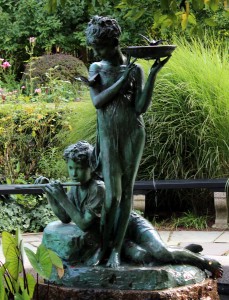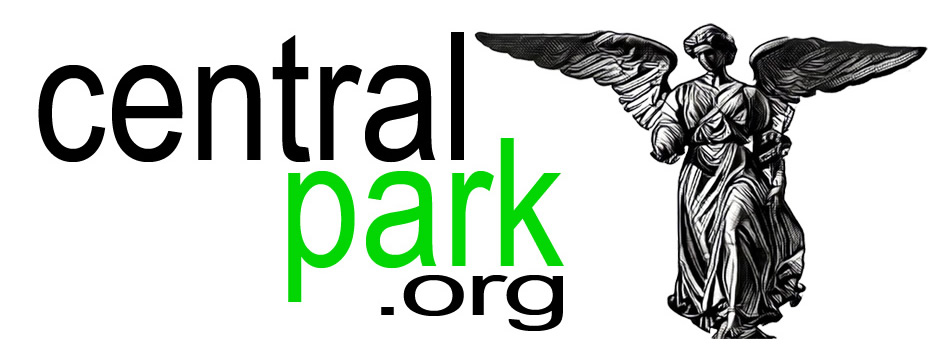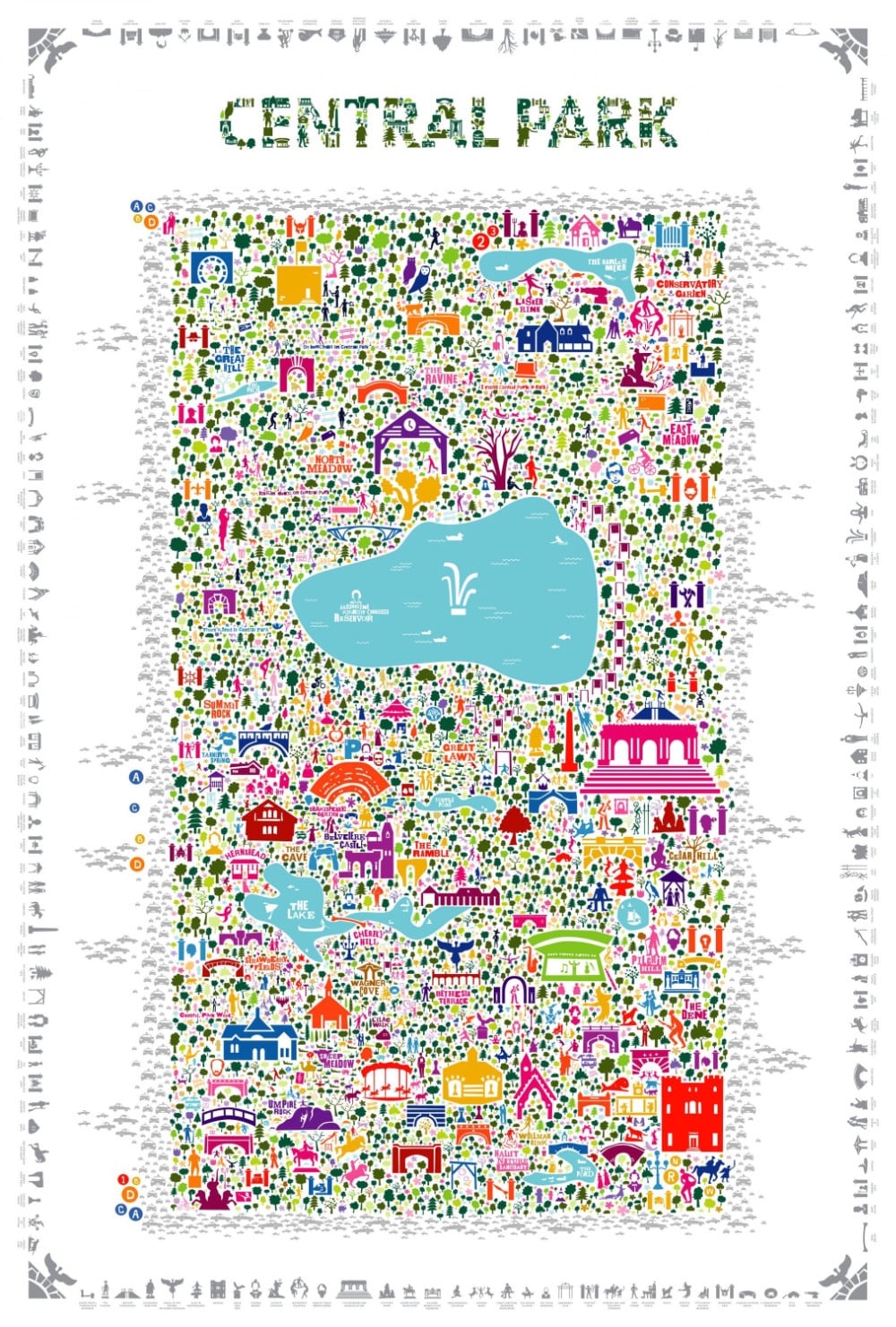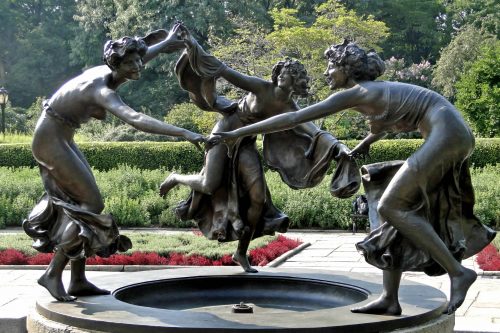Conservatory Garden
One of the hidden wonders of Central Park is the Conservatory Garden at Fifth Avenue and 105th St. A secluded oasis, just a few steps down from one of the City’s busiest thoroughfares; the garden offers a fragrant respite from the gasp and clatter of the urban afternoon.
To enter the six-acre Garden from Fifth Avenue and 105th Street, you must pass through the Vanderbilt Gate. Installed in 1939, it originally served as the entrance to the Vanderbilt Mansion at Fifth Avenue and 58th Street (at the present site of the Bergdorf Goodman department store) until its demolition in 1927. One of the best examples of wrought iron work in New York City, the gate was made in France with designs by American architect George B. Post. The only formal garden in Central Park, the Conservatory Garden derives its name from a huge glass conservatory that once stood on the same spot, which was built in 1898. While not the impressive construct included by Olmsted and Vaux in the original Greensward Plan, it was put to brilliant use by the head gardener of the new park, Ignaz Pilat. It was here that many of the first shrubs and trees that were later planted in the park were first cultivated. When maintenance of the facility became too costly it was torn down in 1934 and replaced with the present garden in 1934.
The Conservatory Garden is filled with a myriad of plant life, from carefully cultivated heirloom roses to the most common of indigenous flowers, while portions of the grounds are delineated by hedges of English yew, barberry, Korean holly and the serendipitously named "Manhattan." The Garden itself is divided into three distinct sections, each representing its own specific style. These are the north (or French Garden), the Central (or Italian Garden) and the south (or English Garden).
The North Garden
The north garden is patterned in the classical French style. At its center is a lovely fountain named the Three Dancing Maidens, constructed in 1910 by the famed German Sculptor Walter Schott. (It is also known, somewhat less euphoniously, as the Untermeyer Fountain, after the family who presented it to the City in 1947.) The fountain is surrounded by sloping beds which display a dazzling array of floral designs, which change seasonally. From the twenty thousand tulips that brilliantly proclaim the end of winter to the 2,000 Korean chrysanthemums which bloom in the fall each change in the climate is marked by yet another brilliant floral display. And representing the four seasons are the four entryways to the garden's center, the arbors festooned with climbing "Silver Moon" roses, which produce gleaming white and pink hued blossoms in June.
The Central Garden
At the center lies the Italian style garden. It is bordered on both north and south sides by walkways lined with crabapple trees, which bloom in the spring. Above it, on the west side, is a wrought-iron wisteria pergola which looks down on a beautiful geyser fountain. This array is especially lovely in the spring when the pergola is covered with violet flowers. In the middle lies the meticulously clipped green lawn, providing a restful and understated stage from which to view the floral extravagance surrounding it. The Italian Garden is also the favorite spot of wedding photographers and virtually any season will find couples from all over the world waiting to have their pictures taken.
The South Garden

The Secret Garden
The southern garden features the English style and as such is much less formal than the other two. It is planted to be enjoyed the year round and almost every week there are new blooms to admire. At the center is a bronze sculpture, the Burnett Fountain, depicting a young boy and girl. Based on characters from The Secret Garden, by Frances Hodgson Burnett the fountain was designed and constructed in 1936 by Bessie Potter Vonnoh. It is surrounded by a reflecting pool upon which float hundreds of water lilies and in which swim dozens of extremely sophisticated goldfish (don’t forget the address).
Ringing the fountain and pool are the seasonal planting beds. Around this are arranged an amazing collection of perennial trees and shrubs, which now features, at its southern end a restful shade garden. Perhaps the most popular of the three the English Garden, with its revolving display of seasonal blooms and quiet, magnolia scented walkways, is the favorite of readers, gardeners, strollers and the contentedly sighing stare-ers into space. Stepping through the Vanderbilt Gates offers not only a change of pace and locale, but also the illusion of temporal transport. You not only leave behind the sights and sounds of the city, but the date as well.
Permission to hold weddings can be arranged by calling (212) 360-2766 or (212) 860-1382.
Location: 5th Ave and 105th St.
Details: The Conservatory Garden is open daily from 8 a.m. until dusk. Free tours start at the front gate Saturday at 11 a.m., April - October.
The CentralPark.org Conservatory Garden section below includes a comprehensive inventory of the twenty-seven flowering plants, shrubs and trees that grace the Garden. And now with The Conservatory Garden Bloom Schedule below, you can not only discover when your favorite flower will be decorating the garden, but you can also find out fascinating background facts about each bloom. Every plant article is also accompanied by a full color photo so identification is easier than ever. So enjoy a stroll around the beautiful Conservatory Garden, either in person or online, and learn more about your favorite blossoms.
Conservatory Garden Bloom Guide
| Astilbe - June - August Baby's Breath - June - July Coneflower - July - September Cornelian Cherry - March Crabapples - April - May Daffodils - March - May Daylillies - June - August Grape Hyacinths - April - May Hellebores - March - April Hollyhocks - June - July Irises - March & May Japanese Anemone - July - October Lilacs, French - May Lilacs, Japanese - June | Magnolias - April - May Oakleaf Hydrangea - July - September Ornamental Grasses - July - October Peony - June Phlox - June - September Purple Coneflower - July - September Rose of Sharon - July - September Roses - June - October Snowdrops - February - March Spiraea - April - May Squill - April - May Tulips - April - May Water Lilies - June - October |
[pano file=”https://centralpark.org/wp-content/uploads/2020/07/617407151.417719-2-scaled.jpg” width=”1200″ height=”800″ title=”Conservatory Garden” panobox=”on”]




